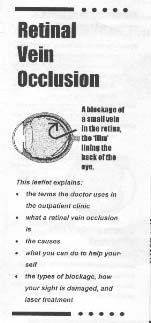Retinal vein occlusion: extra information for professionals David Kinshuck |
|
|
|
Leaflet download |
 |
|
This leaflet is available
|
|
Blood tests |
|
For older patients
For younger patients review specialist articles see and see and see.
|
| Laser to prevent rubeosis |
|
|
|
|
Laser for CSME from a branch retinal vein occlusion |
|
|
CSME = clinically significant macular oedema. My current technique (modified from PubMed)
|
|
|
Laser for/to prevent retinal new vessels |
|
|
|
|
Laser to treat rubeosis (NVG) in CRVO, after V Chong |
|
|
PRP as above, but is this is not possible, either accept (eye may become painful as well as blind) or treat
If your clinic is getting a lot of patients with NVG, increase prevention such as treating risk factors and more laser as above. There is a lot of controversy in the timing of laser in severe CRVO. Some people laser more (and think they prevent more NVG) others laser less (and think they get no more NVG). |
|
|
Identify ocular ischaemic syndrome |
|
See This can be identified by FFA features:
|
|
Optic nerve neurotomy |
|
|
This is experimental, some results are good. Results are not yet consistent and are not recommended for general use as yet see. NICE 2010 review. |
|
|
Incipient RVO |
|
Treat incipient RVO actively to prevent progression, lower eye pressure if borderline. |
|
Epidemiology etc |
|
|
Incidence is 2/1000 over 5 years Risk factors include
For younger patients
|
|
|
Pathogenesis |
|
|
|
|
Intravitreal triamcinolone (IVT) |
|
We have nearly stopped using this treatment and prefer Avastin & laser, see. IVT was considered as a new treatment for the macular oedema that occurs with retinal vein occlusion, see. IVT may improve the sight, but the effect may not last long. There are risks, see , 10% patients developed severe glaucoma.
|
|
Subtenons triamcinolone |
|
see |
|
| Growth factor inhibitors ...
Avastin (IVA) etc
|
|
We would like to use this treatment more but have no funding. Recent reports suggest that regular treatment can be helpful in 25-30% of patients. Intravitreal Avastin is more likely to be helpful, if given early. Search , 2010. Branch retinal vein occlusion Thus lucentis has been found to be effective in branch retinal vein occlusion (BRAVO) , but has to be given repeatedly. PACRSG 2009 Central retinal vein occlusion Similarly lucentis has been helpful in central retinal vein occlusion (CRUISE). Avastin helps in CRVO Wu09 Retina 2011(central). Retinal Vein Occlusion (ie central/branch) BJO 2011 Lucentis helps Various See
research. Intravitreal
bevacizumab (Avastin) treatment of macular edema in central retinal
vein occlusion: a short-term study. Full article. Kreutzer...34
patients repeated injections, some vision improvement. Macugen,
Wroblewski, 09. Triamcinolone and plasmingoen activator
BJO 2011 |
|
|